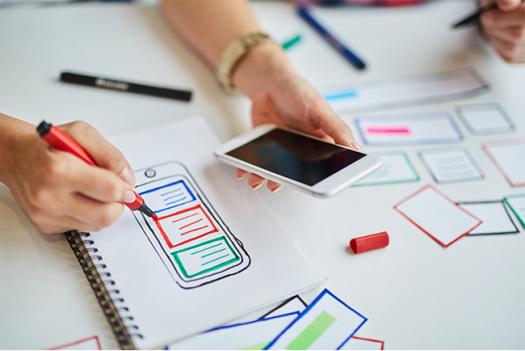The job markt is full of job vacancies for UX Designer. Companies, agencies, media houses - everyone wants people who are concerned about the user experience. Who are they exactly looking for? We have a talk with a professional managing director about the requirements and opportunities in the new job.
‘’Someone who helps people to create positive, effortless and joyful experiences is what we need.” A UX designer has to think holistically about the design of a visual interface. He has to find out what a user needs and how he can get him at every point of his User Journey. In extreme cases, I would expect from a UX designer that he says: Stop, we do not need an interface at all.
A UX Designer is not an interface designer. What are the main differences between these two trades?
This is exactly the crack: UX and interface design are often thrown into a pot. This is because the term user experience and thus the professional image of the UX designer came up only when there were more and more purely digital business models. We could also say the UX Designer is the new digital form of the product designer. And this is the most important difference: the UX Designer has been involved in the development of a digital service right from the start, the Interface Designer is used to design the interface between the product and the people. Every UX designer should be able to visually think, scribble and deal with wireframes. And every designer, whether he/she is classical or digital, always makes conceptual thoughts. Often user experience and interface for a project is also responsible for the same person. Nevertheless, whoever calls himself UX Designer must really penetrate the core of a service and think extremely analytically.
What does this mean to the daily work of UX designer? What does it typically look like?
UX designers are even more involved in research phases than other creatives. For example, if you are working on a digital retail application, it may happen that you have several days in shops near the cash desk and observe how people behave there. In addition, you should write concepts, design personas, record user journeys, and participate in workshops and customer meetings.
Keyword - meeting of customer: The early involvement in the development of a product certainly requires an extremely close cooperation with the client.
Absolutely. Customers increasingly want one of our UX designers to sit with them during the development of a project. All in all, we make sure that our UX designers not only participate in customer meetings, but also discuss their own topics, so that no information is left on the line and we get the best possible results together.
For experienced employees this is certainly no problem. How well is the next generation prepared for such tasks? In other words, how close are the graduates of today to your idea of a good UX designer?
Partially very close. There is a lot of young designers in the agencies, which don’t differ so much between architecture of information and art direction. I don’t want to talk about a generational change, which sounds as if the old silver ridges were not able to think about it. But the young designers find it perfectly normal to sit with the customers - because this is where the product is finally developed. Many of them have already started their own small start-ups while studying, probably driving it against the wall and knowing what it means to sell a digital service. This could also convince a word: with the courage to think entrepreneurially.
How do you feel if someone presents himself to you as a UX designer?
We're still designers, so if someone comes with a great folder, then he has already my attention. I still appreciate it when someone is good at typography and can get something from a line of text. However: A UX Designer must also show me that he can think structurally. His portfolio should include not only surfaces, but also user journeys, concepts for business models, examples of how someone deals with abort rates, and so on.
Must UX Designer learn programing?
Designers should already have a certain understanding of code. Many can program, but this is not a must. I am sometimes amazed at the tools that our UXs can use to create prototypes for websites or apps without coding. This doesn’t necessarily have to be something as professional as Axure, sometimes some Tools can also help you.
UX designers must therefore work with technicians in the team.
Yes, exactly. These can come from the customer, but also from the agency. At all, as a UX Designer, you should be extremely able to work in a team. Normally you work with at least one visual designer, one project manager and one developer. Teams can also be made up of 20 people. As mentioned above, the upswing of digital business models ensures that not only the disciplines, but also the customer and agent sides need to be closer together. People must also be able to get into other forms of contact, at times into a completely different corporate culture. Courage to think entrepreneurially matters.
In which industries are the most exciting projects awaiting UX designers?
In fact, in all sectors, from automotive to retail to tourism. It is not only about technological innovation, but also about social issues. Airbnb is a perfect example of how UX designers have managed to catch up with the spirit of the time and have made a trust-brand out of a business idea - at times a vacant space for a community. The good thing about this is that it not only makes three guys in the Silicon Valley rich, but also - more than in the case of Uber - a social redistribution takes place. Our Mall goes one step further with the idea of cooperative society.
What fascinates you most about being UX designers?
In the UX design does not count, who loudly roars or the most disturbingly disturbed. It is not a matter of creating a sign for a product, but the development of the product itself. A UX Designer is not a loud rock star, but everyone who knows, no matter what you do, it only works when the People like to use it.
Read more:



Comments
Post a Comment